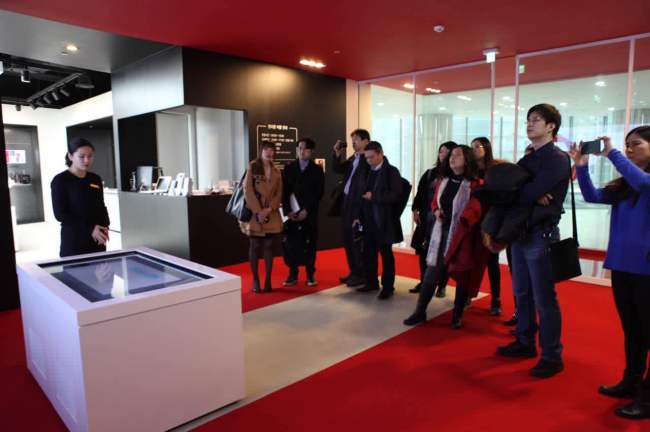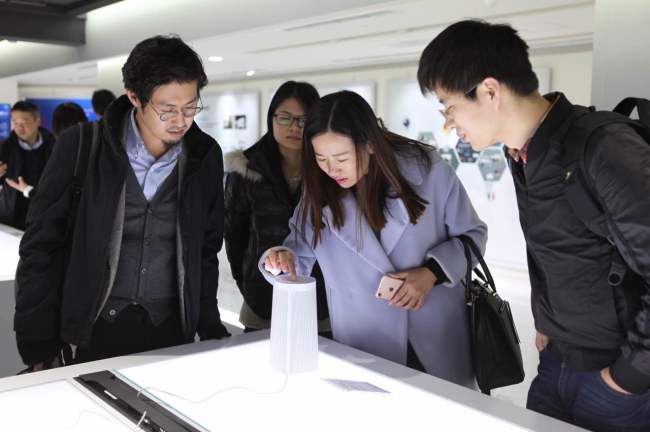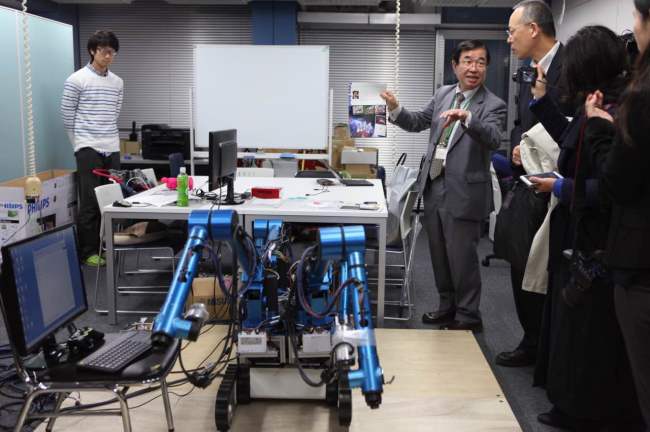[FROM THE SCENE] East Asia gears up for next industrial revolution
China is aggressively following Japan in the lead, while Korea remains sandwiched between them as initiative falters due to political scandal
By Park Ga-youngPublished : Nov. 29, 2016 - 21:01
The Korea Herald is publishing a series of articles on the moves made by the companies and governments of South Korea, China and Japan in entering the new industry 4.0 era. This is the first installment. -- Ed.

Beijing’s InnoWay, Osaka’s Knowledge Capital and Pangyo’s Gyeonggi Center for Creative Economy and Innovation are hotbeds of innovation in East Asia.
These sites are where Korea, China and Japan are pinning their hopes for the fourth major upheaval in manufacturing and the information and communication technologies revolution.
And the fervor of activity and competition was felt during a joint media trip of nine reporters -- three from each country -- from Nov. 7 to 18 in seven cities across Korea, China and Japan.
All three governments see the new industrial revolution as irreversible, and have rolled out policies to gain a competitive edge in future growth engines such as the Internet of Things, 5G, artificial intelligence, big data, electric cars, drones and robotics.

China has a master plan called “Made in China 2025,” as part of its 13th Five-year Plan adopted in March.
Japan also unveiled a plan called the “New Industrial Structure Vision” in April that was inspired by Germany’s Industry 4.0.
South Korea’s Creative Economy Initiative, which began in 2013, involves technology innovation as one of its two pillars.
Although each of them have different catchphrases, their gist is the same -- ICT and innovation.
How they are distinct from one another, however, is in how those government-led initiatives and efforts are being translated into innovation.
In Beijing and Shenzhen, China’s innovation ecosystem was most vibrant as the government initiative there is boosted by China’s thriving entrepreneurial scene.
Officials from drone maker DJI and electric carmaker BYD mentioned their goal to replace the old image of “made in China” with the brand-new “created in China,” which is one of the goals of the new government policy.

Japan wants to widen its gap with competitors like Korea and China, both of which have been chasing or even transcended Asia’s No. 2 economy in electronics and other manufacturing sectors.
“After the war, Japan did well in maintaining its economy. But in this rapidly changing world -- so rapid that the word IT seems outdated -- I think Japan is slow to adapt,” Fukuda Tatsuo, a member of the Japanese House of Representative, told reporters during an interview on Japan’s innovation.
Japan said in April that it lagged behind in terms of providing platforms for virtual data, which it calls the first phase of Industry 4.0.
However, the country has a competitive edge in utilizing real data such as health information, driving data and factory data, according to a government report. And such efforts were seen during a visit to the Waseda Universitiy Future Robotics Organization, electronics firm Omron and Japan’s telecommunication giant NTT which are trying to develop commercial services with IoT, AI and robots in the very near future.
Amid the political debacle embroiling President Park Geun-hye, South Korea’s creative economy initiative is facing perhaps the biggest challenge. During an interview, a government official said that he felt distraught because the initiative had been reduced due to its ties to Park.
Koo Hyuk-chae, director of the creative economy planning division at the Ministry of Science, ICT and Future Planning, told reporters, “The ICT-driven creative economy has little to do with the Choi Soon-sil scandal and as a department dealing with economic policies and strategies, we will continue to carry out our plans.”
Despite political instability here, startups at the Gyeonggi Center for Creative Economy and Innovation, one of 18 centers around the country, and Maru180, a startup incubator and co-working space, young businesspeople showed avid enthusiasm as they try to break through the globally competitive innovation scene.
But passion may not enough to survive this fierce innovation scene. “Failure is not accepted here and many regulations discourage people,” a Korean government official said at the end of the two-week trip.
By Park Ga-young (gypark@heraldcorp.com)








![[Graphic News] More Koreans say they plan long-distance trips this year](http://res.heraldm.com/phpwas/restmb_idxmake.php?idx=644&simg=/content/image/2024/04/17/20240417050828_0.gif&u=)
![[KH Explains] Hyundai's full hybrid edge to pay off amid slow transition to pure EVs](http://res.heraldm.com/phpwas/restmb_idxmake.php?idx=644&simg=/content/image/2024/04/18/20240418050645_0.jpg&u=20240419100350)






![[From the Scene] Monks, Buddhists hail return of remains of Buddhas](http://res.heraldm.com/phpwas/restmb_idxmake.php?idx=652&simg=/content/image/2024/04/19/20240419050617_0.jpg&u=20240419175937)

![[KH Explains] Hyundai's full hybrid edge to pay off amid slow transition to pure EVs](http://res.heraldm.com/phpwas/restmb_idxmake.php?idx=652&simg=/content/image/2024/04/18/20240418050645_0.jpg&u=20240419100350)

![[Today’s K-pop] Illit drops debut single remix](http://res.heraldm.com/phpwas/restmb_idxmake.php?idx=642&simg=/content/image/2024/04/19/20240419050612_0.jpg&u=)